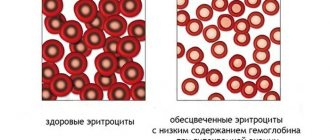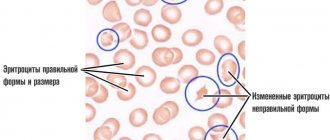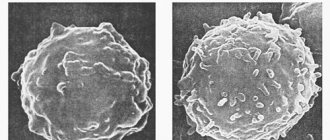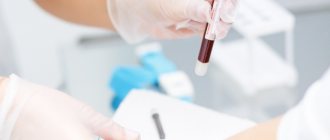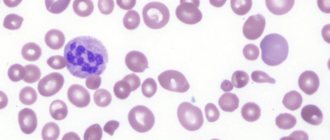Why does anemia occur, and what are the causes of its occurrence in adult men and women? What are the laboratory signs of this condition, and what blood test for anemia should be taken first: a biochemical or general blood test?
Anemia is usually translated as “anemia,” but if we translate this word literally, then it is “bloodlessness,” since the prefixes “a” and “an” are negative. Of course, one hundred percent blood anemia is impossible, but doctors of various specialties often encounter clinical and laboratory manifestations of anemia. These common symptoms include dizziness, ringing in the ears, pallor, shortness of breath, and decreased exercise tolerance.
Causes of anemia syndrome
The number of reasons leading to the development of anemia is very large. They can be divided into external and internal. External factors include the influence of environmental factors, nutrition, and internal factors include diseases and developmental abnormalities.
External reasons
Since a person receives iron and various proteins that form hemoglobin from food, iron deficiency, fasting, and lack of vitamins such as ascorbic and folic acid lead to anemia. Vitamin B12, or cyanocobalamin, plays a special role. Its deficiency causes severe anemia, which was previously called malignant or pernicious anemia.
External factors also include the use of various chemicals, occupational chronic intoxication and acute poisoning, and the influence of certain medications. These are arsenic and benzene, drugs such as cytostatics, some antibacterial drugs, hormones, thyreostatics. Thyreostatics include drugs that reduce the production of hormones by the thyroid gland. Also, some anticonvulsants can cause anemia syndrome with long-term use.
Of course, the simplest cause of anemia is bleeding. In the case of acute blood loss, the patient is threatened not so much by anemia as by hemorrhagic shock, but with a long period of recovery from major blood loss, it is quite possible to talk about the development of anemia. Much more often, small but regular blood loss, which is chronic, leads to anemia.
Many people believe that donation can lead to anemia. Of course, this is true, but according to existing rules, the frequency of blood donations from donors is strictly regulated. Thus, the donor cannot repeat the procedure if 60 days, or two months, have not passed since the previous donation. In addition, there is a limitation of the other plan. During a calendar year, a man can donate blood no more than 5 times, and a woman no more than 4 times.
Internal reasons
A large group of internal causes of anemia syndrome are hereditary or genetic diseases. These are defects in the structure of hemoglobin that cause thalassemia and sickle cell anemia. Also, disruption of the functioning of enzymes in erythrocytes, or disturbances in the formation of the cellular skeleton, leads to anemia, defects of erythrocytes, which are manifested by changes in their size and shape, for example, Minkowski-Choffard disease. With this disease, red blood cells cease to resemble biconcave discs and become like balls.
Impaired absorption of various substances in the intestine can also lead to chronic anemia, the most common diseases being glomerulonephritis and tuberculosis, chronic viral hepatitis and cirrhosis. All diseases that lead to bleeding can also be attributed to predisposing factors for the development of anemia. These are malignant neoplasms and stomach ulcers, ulcerative colitis and Crohn's disease.
Finally, there are physiological factors for the occurrence of anemia, for example, anemia in women can often occur against the background of long and heavy periods. Of course, nature prevents severe blood loss, since menstrual blood is much poorer and is not blood in the full sense of the word. This is nothing more than the inner lining of the uterus, or endometrium, which has become unnecessary.
Prevention and prognosis
The outcome of anemia is determined by its severity, timeliness of diagnosis and the adequacy of the selected treatment. Acquired variants can be cured with adequate management. Hereditary forms can be put into stable remission. The development of chronic kidney disease and disseminated intravascular coagulation syndrome increases the risk of mortality. The development of acquired hemolytic anemia can be prevented by timely treatment of pregnant women at risk of antigenic incompatibility with the fetus, prevention and treatment of infections and intoxications. Before prescribing medications, vaccinations or blood transfusions, the patient should be thoroughly examined and all risks of incompatibility and immune reactions should be taken into account.
Postnova Maria, general practitioner, medical columnist
1, total, today
( 66 votes, average: 4.59 out of 5)
Lymphoblastic leukemia: symptoms and treatment
Prevention of spring vitamin deficiency
Related Posts
What does anemia “consist” of?
Human blood is a unique liquid tissue that has many different functions, from transport to protective. Most of the various substances that it contains, such as bilirubin, proteins, enzymes, electrolytes, are molecules and can be examined by performing a biochemical blood test.
But at the same time, the main and most important function of this fluid is respiratory. Blood transports oxygen from the lungs to all organs and tissues, and releases carbon dioxide back for gas exchange. She does this through the respiratory pigment hemoglobin, which is found in red blood cells - erythrocytes. Therefore, the transport of oxygen and carbon dioxide falls entirely within the competence of red blood cells.
All of the listed symptoms associated with oxygen deficiency refer to the pathology of red blood cells or hemoglobin. Therefore, laboratory signs of any anemia will be various conditions that lead either to a decrease in hemoglobin concentration or to a decrease in the number of red blood cells in a standard volume of blood. Accordingly, these two processes lead to a decrease in the hematocrit analysis, which we wrote about in the article “Hematocrit (HCT) in blood analysis,” this indicator reflects the ratio of the cellular composition of the blood to its liquid part, or plasma.
Therefore, the first test is a simple and routine complete blood count. It used to be taken from a finger, that is, capillary blood, but now it is increasingly taken from a vein in the elbow.
If we are talking about a blood test for anemia, then most often this means a regular general blood test. Almost all the norms that exist in this analysis and relate to red blood indicators are basic for the primary diagnosis of anemia syndrome. What data from a general blood test indicate anemic syndrome?
Diagnostic methods
Diagnosis of hemolytic anemia is carried out by a hematologist. He makes a diagnosis based on data obtained during examination of the patient. First, anamnestic data is collected and the presence of trigger factors is clarified. The doctor assesses the degree of pallor of the skin and visible mucous membranes, conducts a palpation examination of the abdominal organs, during which an enlargement of the liver and spleen can be determined.
The next stage is laboratory and instrumental examination. A general analysis of urine, blood, and biochemical examination is carried out, during which it is possible to determine the presence of a high level of indirect bilirubin in the blood. An ultrasound of the abdominal organs is also performed.
In especially severe cases, a bone marrow biopsy is prescribed, in which it is possible to determine how red blood cells develop in hemolytic anemia. It is important to carry out correct differential diagnosis in order to exclude pathologies such as viral hepatitis, hematological malignancies, oncological processes, liver cirrhosis, obstructive jaundice.
General blood test data
Nowadays, when tests for anemia are performed automatically, using biochemical analyzers, it has become possible to study a large number of different erythrocyte indices, which can help the doctor in diagnosing anemia. We will not go into details, and will name only the most important indicators that will help determine anemia:
- the size of red blood cells, or the average diameter of red blood cells. There are varieties of anemia, which are accompanied by both an increase in the diameter of blood cells and a decrease in their size, or normal size.
Normal sizes include a range of 80 to 100 cubic micrometers for each blood cell. Accordingly, anemia can also be normocytic, microcytic, and macrocytic;
- color index, CPU. This value shows the “brightness” of the color of red blood cells and depends on their saturation with the respiratory pigment hemoglobin.
If the color index is less than 0.85, then this indicates a decrease in hemoglobin in red blood cells, and corresponds to the amount of hemoglobin less than 30 g per deciliter, g/dl. In this case we will talk about hypochromic anemia. At the same time, there are both normochromic and hyperchromic variants of anemia, in which the color index will fluctuate around one, and the average hemoglobin content in erythrocytes will also be normal, from 30 to 38 g/dl;
- Also, poikilocytosis, or the appearance of various non-standard red blood cells of various shapes and sizes, can be detected in red blood.
This symptom suggests that in conditions of iron deficiency, which occurs with iron deficiency anemia, red blood cells are produced in the red bone marrow that are far from the standard, made “from what was available”;
- the presence of an increased number of reticulocytes (more than 1%).
Reticulocytes are young and immature red blood cells in which the primary nucleus has not yet been completely removed, and this structure resembles a network, hence the name. An increase in the number of reticulocytes indicates a lack of red blood, or an increased rate of destruction of these cells. As a rule, altered and defective red blood cells are destroyed at an increased rate, for example, with the same hereditary Minkowski-Choffard microspherocytosis.
- Also, in a general blood test, hematocrit is determined, which indirectly indicates the development of anemia.
When you donate blood, it is centrifuged to separate a heavy layer of red blood at the bottom and a lighter layer of plasma at the top. In men, the normal hematocrit level should not be less than 0.4, and in women it should not be less than 0.36. When this value decreases, anemia syndrome may occur.
What substances and their changes characteristic of anemia can be detected in a biochemical blood test?
Treatment
Inpatient therapy. This is the only way doctors can monitor the patient and respond to changes in a timely manner. Treatment of hemolytic anemia is mainly medicinal.
What drugs are used:
- Vitamins. To maintain the body, restore its functions, and rapid maturation of red blood cells.
- Antibiotics. According to need. If there is a need. Select products with a wide spectrum of action. Cephalosporins, in exceptional cases - fluoroquinolones.
- In the autoimmune form of the pathological process, hemolysis must be stopped. Glucocorticoids are used. Like Prednisolone and similar drugs. But in short courses. They cannot be taken for a long time.
- Autoimmune varieties of the disease also require the use of immunosuppressants. In small courses, as is the case with steroids.
During the main treatment, the patient's condition is constantly monitored. Otherwise, you may miss complications.
Conservative therapy also includes:
- Blood and red blood cell transfusions. Regularly. According to need.
- Administration of infusion solutions. Glucose. Magnesium sulfate or sodium chloride.
If therapy is ineffective, surgery cannot be avoided. Splenectomy is indicated. That is, removal of the spleen. For some forms of pathology, such as hereditary syndromes, this is a 100% cure method. There are no other options.
Hemoglobin binding disorders are corrected using plasma substitutes. Antiplatelet agents are prescribed as needed. Medicines that thin the blood. To prevent the formation of blood clots.
Each type of anemia is treated differently. In any case, it is necessary to eliminate intracellular hemolysis and the influence of external factors. The task is not easy. Recovery requires up to several months of hard work.
Blood chemistry
Biochemical research involves determining:
- the concentration of iron in the blood serum - this indicator is called serum iron.
If total serum iron in women is less than 9, and in men less than 11.6 micromol per liter, then we can talk about iron deficiency anemia.
We recommend taking a short test “Does your body have enough iron?”.
- The concentration of a special protein called ferritin is determined, and it is able to transport iron in a bound state.
Determining ferritin reliably shows how much stored or deposited iron exists in the body, and by determining ferritin, the doctor assesses the supply of iron in the blood. In adult women, the ferritin level should not be below 10 micrograms per liter, and in men - below 20. Moreover, a decrease in the ferritin value indicates only two conditions: IDA, or iron deficiency anemia, and an intestinal disease called celiac disease.
- finally, the ability of blood serum to bind iron (TIB, total iron-binding capacity of serum) is examined; usually in anemia it is increased if we are talking about iron deficiency. Normally it ranges from 16 to 54 (average 31.2)
Determining ferritin reliably shows how much stored or deposited iron exists in the body, and determining levitin assesses the supply of iron in the blood. Research on this protein is very important. After all, in adult men and women, the level of ferritin in women should not be lower than 10 micrograms per liter, and in men it is less than 20. Moreover, a decrease in the value of ferritin indicates only two conditions: iron deficiency associated with the development of iron, and intestinal diseases, which called celiac disease or spore.
Listed above are the main indicators of a biochemical blood test for anemia, which are studied first. But experts also pay attention to other research results. Thus, the bilirubin indicator provides important information to the doctor, since it is the final product of hemoglobin breakdown. Some types of anemia, which are associated with increased hemolysis, or breakdown of blood cells, manifest as jaundice or increased bilirubin levels.
It is important to assess the level of folic acid in the body, the concentration of vitamin B12, markers of autoimmune and rheumatic diseases. Finally, in difficult cases, if blood cancer is suspected, a puncture of the red bone marrow is performed, through which the function of hematopoiesis is examined.
Symptoms
The clinical manifestations of hemolytic anemia are quite extensive, but their nature always depends on the cause that caused the disease, one or another type. Sometimes the pathology manifests itself only when a crisis or exacerbation develops, and remission is asymptomatic, the person does not make any complaints.
All symptoms of the process can be detected only during decompensation of the condition, when there is a pronounced imbalance between healthy, developing and destroyed blood cells, and the bone marrow cannot cope with the load placed on it.
Classic clinical manifestations are represented by three symptom complexes:
- anemic;
- icteric;
- enlargement of the liver and spleen – hepatosplenomegaly.
They usually develop with extravascular destruction of formed elements.
Sickle cell, autoimmune and other hemolytic anemias manifest themselves with such characteristic symptoms.
- Increased body temperature, dizziness. It occurs when the disease develops rapidly in childhood, and the temperature itself reaches 38C.
- Jaundice syndrome. The appearance of this symptom is due to the destruction of red blood cells, which leads to an increase in the level of indirect bilirubin, which is processed by the liver. Its high concentration promotes the growth of stercobilin and urobilin in the intestines, due to which feces, skin, and mucous membranes are colored.
- As jaundice develops, splenomegaly also develops. This syndrome quite often occurs with hepatomegaly, that is, both the liver and spleen enlarge at the same time.
- Anemia. Accompanied by a decrease in the amount of hemoglobin in the blood.
Other signs of hemolytic anemia include:
- pain in the epigastrium, abdomen, lumbar region, kidneys, bones;
- heart attack-like pain;
- malformations of children, accompanied by signs of disruption of intrauterine fetal formation;
- change in stool character.
Read also Polycythemia vera. Causes, treatment, prognosis

